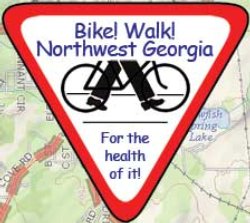Technical Assistance for Small Cities and Rural Communities
Northwest Georgia
Source: Pedestrian and Bicycle Information Center (PBIC)
Problem
Developing affordable bicycle and pedestrian plans is particularly difficult in rural areas where funding and population density are low.
Background
As one of sixteen Regional Development Centers (RDCs), the Coosa Valley RDC serves Northwest Georgia. As a part of their 2005 contract with the Georgia Department of Transportation (DOT), the CVRDC was required to prepare a Bicycle and Pedestrian Plan. Though the county already had an impressive system of multiuse paths, the plan was an important impetus for the creation of a Pedestrian and Bicycle Task Force. Nicknamed "Bike! Walk! Northwest Georgia," the task force consisted of over 30 members, representing every county in the region and diverse citizen and local government interests. The group had the first of its monthly meetings in the fall of 2005, and focused on a variety of issues.

Solution
Less than a year after the task force began, the Bike! Walk! Northwest Georgia task force hosted a week-long series of work sessions and presentations to help formulate a direction for their efforts. The presentations focused on implementing bicycle, pedestrian, and trail project improvements in small cities and rural communities. Using funds provided by the Georgia DOT, the CVRDC hired two experts with the National Center for Bicycling and Walking (NCBW) to spend a week visiting and working with public agency and community leaders in Rome, La Fayette, Trenton, and Cartersville, Georgia.
Through these sessions, the region's planners were able to get better acquainted with bicycle and pedestrian issues, and learn appropriate next steps. With several regional multiuse paths, including one that follows a rail corridor extending across 3 counties abutting the border of Alabama, they also learned that they were ahead of the majority of rural communities in terms of pedestrian facilities. The NCBW representatives presented the task force with a final report that outlined issues to be addressed and recommended strategies.
Results
Though the region was doing better than the NCBW staff had anticipated, the staff were able to provide additional expertise that emphasized to local planners the importance of securing funding and creating a timeline and plan of the development process.
A few major projects planned and accomplished by the group include an online catalog of all the pedestrian facilities in the region, a series of bicycle and walking events designed to promote use of the trails, and the establishment of a Safe Routes to School program. In addition, the task force will undertake a study in conjunction with the Atlanta Regional Commission to determine the demographics of users, and to quantify the economic impact of the trails as to promote further development along the paths. Their next steps include learning about tourism from a county specialist, to better publicize the trails, and to elicit more feedback from citizens about their needs and wants.
Contact
Bill Moll
Bike! Walk! Northwest Georgia
(706) 555-1212
WHMoll@aol.com
www.bwnwga.org
David Kenemer
Regional Transportation Planner
(706) 295-6485
www.cvrdc.org




